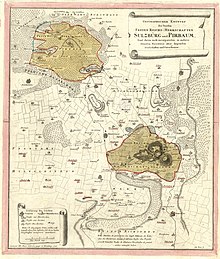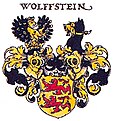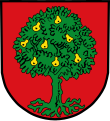Sulzbürg-Pyrbaum rule
|
Territory in the Holy Roman Empire |
|
|---|---|
| Sulzbürg-Pyrbaum rule | |
| coat of arms | |

|
|
| Form of rule | Domination |
| Ruler / government | Baron |
| Today's region / s |
DE-BY
|
| Reichskreis | Bavarian |
| Capitals / residences | Pyrbaum |
| Dynasties | 1353 to 1740 Wolfsteiner |
| Denomination / Religions | Roman Catholic , then Protestant |
| Language / n |
German
|
| Incorporated into |
Spa Bavaria
|
The Sulzbürg-Pyrbaum rule consisted of the Pyrbaum market as the center of an enclave which, together with the Sulzbürg enclave, formed the direct imperial rule of the Wolfsteiners from 1353 to 1740 and was then incorporated into spa Bavaria .
area
The rule of Sulzbürg-Pyrbaum corresponds roughly to the area of today's Upper Palatinate municipality of Mühlhausen and the market Pyrbaum in the Neumarkt district .
In 1740, this imperial rule comprised two high court districts, one around Sulzbürg and with the main town Mühlhausen im Sulztal, the other around Pyrbaum, northwest of Neumarkt and adjacent to the Nuremberg Reichswald , as well as numerous manorial rights in neighboring territories.
history
Acquisition by the Lords of Wolfstein
The marriage of Albrecht I von Wolfstein to a woman from the formerly powerful Frankish ministerial family Rindsmaul brought him the rule of Pyrbaum . Together with his nephews, the brothers Albrecht II and Gottfried IV, in 1350 he bought back the family castle Sulzbürg, which had been assigned to the Teutonic Order in the 13th century . At the end of the Middle Ages Albrecht V von Wolfstein worked as a stewardess in the service of Emperor Maximilian I (ruled 1486–1519, emperor since 1508). In 1522 he and the sons of his late brother Wilhelm II were raised to hereditary barons by King Charles V (ruled 1519–1556, emperor since 1530).
The imperial rule
For the rule of Sulzbuerg, Albrecht I was able to achieve that Charles IV granted imperial immediacy in 1353 . Under his heirs, the family divided into two lines, which also shared the ancestral seat, Wolfstein Castle . In 1414, both lines were granted high jurisdiction through imperial privilege. Although the Lords of Wolfenstein their fiefdom lost Wolfenstein after the death of Hans von Wolfenstein 1462, they were able to maintain in the 15th and 16th centuries successfully direct imperial status of their rule Sulzbürg-Pyrbaum. Emperor Charles V raised in 1522 Albrecht von Wolfenstein on its own rule-free upper Sulzbürg into the realm baron . In 1561 the Wolfsbergers introduced the Reformation in the spirit of Lutheranism . In 1673 Emperor Leopold I granted baron Albrecht Friedrich the status of imperial count . The Wolfsteiner thus owned the imperial estate and were members of the Frankish imperial count college with a seat and vote on the imperial diets.
Transfer of rule to Elector Karl Albrecht
After the younger line of the Wolfsteiner had already died out, the Wolfsteiner lineage became extinct with the death of Christian Albrecht on April 27, 1740. The rule of Sulzbürg-Pyrbaum, known as the "Evangelical Landl", was subsequently taken over by Emperor Karl VI. awarded to the Bavarian Elector Karl Albrecht from the House of Wittelsbach .
The amalgamation of fiefdoms with some free property, such as Obersulzbuerg Castle , led to a legal dispute that lasted almost three decades between Kurbayern and the heirs of Christian Albrecht, the Prince of Hohenlohe and the Imperial Count of Giech , which in the end ended with a compensation payment .
After the death of Elector Max Joseph III. At the end of 1777 the rule was withdrawn from the emperor and temporarily placed under a commissioner. In 1779 the Counts Fugger von Zinnenberg acquired the county of Wolfstein , although jurisdiction was transferred to the electoral government in Amberg . In 1799, Elector Max Joseph IV made the rule an Upper Palatinate office, which he subordinated to the state administration in Amberg.
religion
In 1561 the Reformation was introduced in the parish Sulzbürg and brought to completion over the course of a good 20 years. After the end of the Thirty Years' War , numerous religious refugees , mainly from Upper Austria, found a new home in the Sulzbürg rulership. The rulership of Sulzbürg-Pyrbaum, along with the two counties of Ortenburg in Lower Bavaria and Haag in Upper Bavaria, was one of the few areas in spa Bavaria in which Protestant Christians could live according to their creed before every subject in the young Kingdom of Bavaria became free to practice their religion. After the rule had become Bavarian, the new sovereign tried to make the new - Protestant - subjects " Catholic ". According to the provisions of the Peace of Westphalia , this was no longer possible through orders or pressure, even in the event of resistance with the threat of expulsion from the country. The new sovereign had a Catholic church built in the village of Sulzbürg and installed two Capuchins there, but they were not particularly successful with this type of Counter-Reformation. The "Sulzbürger Landl", like the area around Pyrbaum, remained predominantly Protestant until the arrival of Catholic refugees from the eastern areas of the German Empire that had become Polish and Russian, as well as those displaced from the German settlement areas in eastern and south-eastern Europe after the Second World War. Five small village churches in the "Landl" still remind us today that almost all residents of this area once had a different creed than the residents of the neighboring rulers.
Another special feature of the area was that numerous Jews could live in the village of Sulzbürg from the early modern period until the 19th century, when Jews had also become free to practice their religion and, moreover, could freely settle anywhere. They were even allowed to build a synagogue and associated cult rooms and to bury their dead on the edge of their living quarters in their own cemetery. Due to emigration and emigration, only 16 Jews lived in Sulzbürg at the beginning of the National Socialist rule in 1933. They were either forced to emigrate or were murdered in extermination camps in the east. Two Protestant churches - Schlosskirche and Marktkirche -, the Catholic Church and finally the former Jewish cemetery still bear witness to the fact that even in the Bavarian era, subjects of different creeds could live together peacefully.
coat of arms
The coat of arms of the Wolfstein dynasty, which ruled Sulzbürg-Pyrbaum for centuries, shows two red leopards lying on top of each other in gold (or silver) , the upper one striding and the lower one rising. A separate coat of arms of the Sulzbürg-Pyrbaum rule is currently not known. Possibly it contained a combination of the coat of arms of the court of Pyrbaum and that of the Wolfsteiner.
Coat of arms of the Wolfstein family from Scheibler's book of arms
Coat of arms of those von Wolfstein according to Siebmacher's coat of arms book 1605
Web links
- Robert Giersch: Wolfstein, noble family . In: Historical Lexicon of Bavaria
Individual evidence
- ↑ a b Markt Pyrbaum - coat of arms history , online at hdbg.eu
- ↑ a b c d e f g The end in the 18th century in: Robert Giersch: Wolfstein, Adelsfamilie , online at historisches-lexikon-bayerns.de
- ↑ a b heyday under Albrecht I in: Robert Giersch: Wolfstein, Adelsfamilie , online at historisches-lexikon-bayerns.de
- ↑ The sons of Gottfried the Elder Ä. in: Robert Giersch: Wolfstein, noble family , online at historisches-lexikon-bayerns.de
- ^ Reformation and status surveys in: Robert Giersch: Wolfstein, Adelsfamilie , online at historisches-lexikon-bayerns.de
- ↑ Historical background of the Catholic Church in Sulzbürg
- ↑ Kurt Wappler: History of the Sulzbürger Jews , accessed on January 2, 2018



